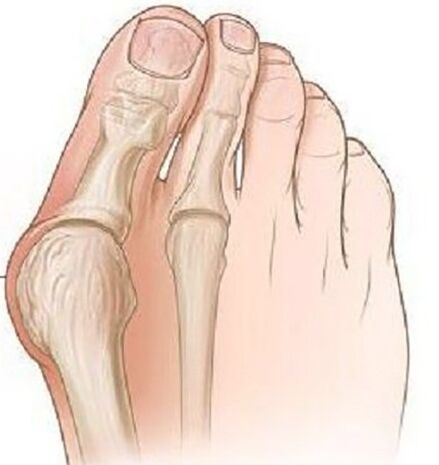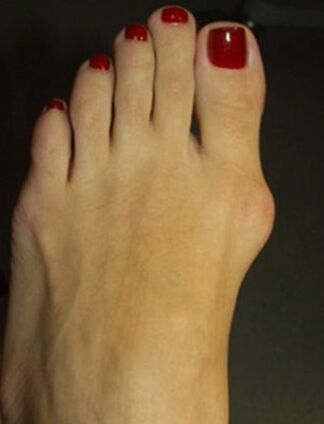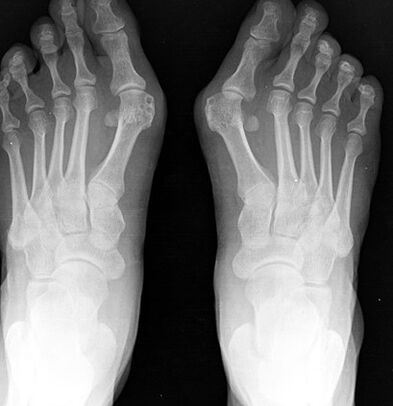The walgus deformation of the thumb foot is the most common acquired foot deformation, which characterizes the deviation from the thumb.
The pathology is bilateral in nature, mostly affects women over 35 years.In most cases, deformation is accompanied by chronically inflammation of common bags and deformation of plusephalang compounds, allocated deviations of the first metatarsal bone.

The causes of the disease.Why is it dangerous?
The etiological causes of deviation from Valgus, the leg of the leg are not yet fully studied.There are several phenomena theories:
- Vestigian theory.In the middle of the 19th century, it believed that only models were subject to this deformation due to the use of model shoes in high, but during the study, this pathology was found in men who wore straight shoes.
- The theory of primary muscle weakness - was rejected in a detailed study of the problem.
- The theory of the weakness of the ligamental apparatus and the lack of aponeurosis of the solution - most scientists adhere to this theory.
There are several factors leading to the debut of this pathology:
- Excess weight increases the load on your feet.
- Age -Illeta dystrophic changes in ligamental articular apparatus.
- Weekens Heel shoes are more than 5 cm, they are narrowed on the toe.
- Existing deformations of the skeleton (Scoliosis, deformation of walgus thigh and knees, flat feet).
The danger of pathology lies in the fact that these deformations lead to the deformation of posture, it is possible to develop dystrophic depths of spine, hook and knees during the irregular distribution during walking, and violation of the feet in the accompanying pain, which significantly exacerbates the benefits of the person.
Clinical manifestations
At the beginning of the disease, the deformation of Valgus is not shown clinically.Most women are more worried about the appearance of the foot - increasing the metacarpal-phalan joint and the first finger spout becomes noticeable.

Over time, pain appears, first when they wear tight shoes and extended walking, and later pain begins to be permanent, painful.
Due to improper weight distribution, limb, the first and other finger on the soles, form the corn, the second finger is raised, difficult to extend, the fingers of "Malleus", which is largely alleviated by walking.Due to the deterioration of blood circulation and innervation in the front of the foot, arthrosis and chronic bursitis is developed.
Diagnostics
- During the objective examination, classic deformation is visible with the deviations from Valgus thumb, the distal part of the foot was expanded.In the head of the head of the first metatarsal bone, there are signs of OPRTESTE - hyperemia and edema skin, pain during palpation.
- Foot radiography in two projections.The front projection determines the degree of thumb, the state of the metacarpal-phalan compound, the degree of transferring the sesoid bone, and in the side projection, the degree of flat feet is visualized, which is very often happening with the front finger foot.
- Fantagion.On the footprint, made on paper, the line is located through the middle of the heel and between the fourth and third fingers, the outer foot set is formed, according to which the presence of footing and its diplomas is assessed.In these patients, flattened feet or flat feet of the first degree are detected in these patients.
Treatment and prevention
Depending on the weight of the process, conservative or surgical treatment are carried out.
Conservative treatment is performed in a slight stage of the disease, various types of orthopedic cartridges, which are selected individually and deliver a deformed finger to a normal position, while the load on the front of the limb stabilizes and distributes.
In the children's and senile age, the transverse bend of remote limbs with laying between the first and second fingers is used.To reduce pain, warm bath baths with sea salt and soda are used, the radon baths give a good result.
Local anti -infalmartic gels are used to combat Bursitis, compressing the dimexide and lidocaine, and the pronounced pain are used by the blockages and intraisticular injections of glucocorticoids.

Surgical treatment is possible at any stage of the disease, is carried out in local anesthesia, which reduces the list of contraindications for surgery.
In the first phase, the cold growth of bones are removed on the internal edge of the bone, while it is possible to just reduce the pain in the process, but not to prevent deformation development in the future.
With a severe finger deviation, with the presence of straight feet, osteotomy is done in the bottom of plus the first finger using a bone blade to reject the finger into a normal position, with the help of Lavan tape, the transverse ligament is formed.After surgery, the leg is firmly secured by a bend for 4 weeks, the use of individual orthopedic cartridges is recommended during the year.
Disease prevention is the use of comfortable shoes without high heel, shoes should be free to sit on the leg, a narrowed toe should not bring discomfort in thumb.If there are certain skeleton deformations, it is recommended that preventive overviews of the orthopede undergoes the identification and slowing down of the progression of the Deformation of Valgus thumb.
Consequences and complications
The process complication is the development of deichländer or "Marta" foot, which characterizes acute pain, due to microcracks in pairing foot compounds and tendolditis.
Due to the permanent inflammatory process and mechanical damage, there is a risk of developing malignant neoplasms of bones.























